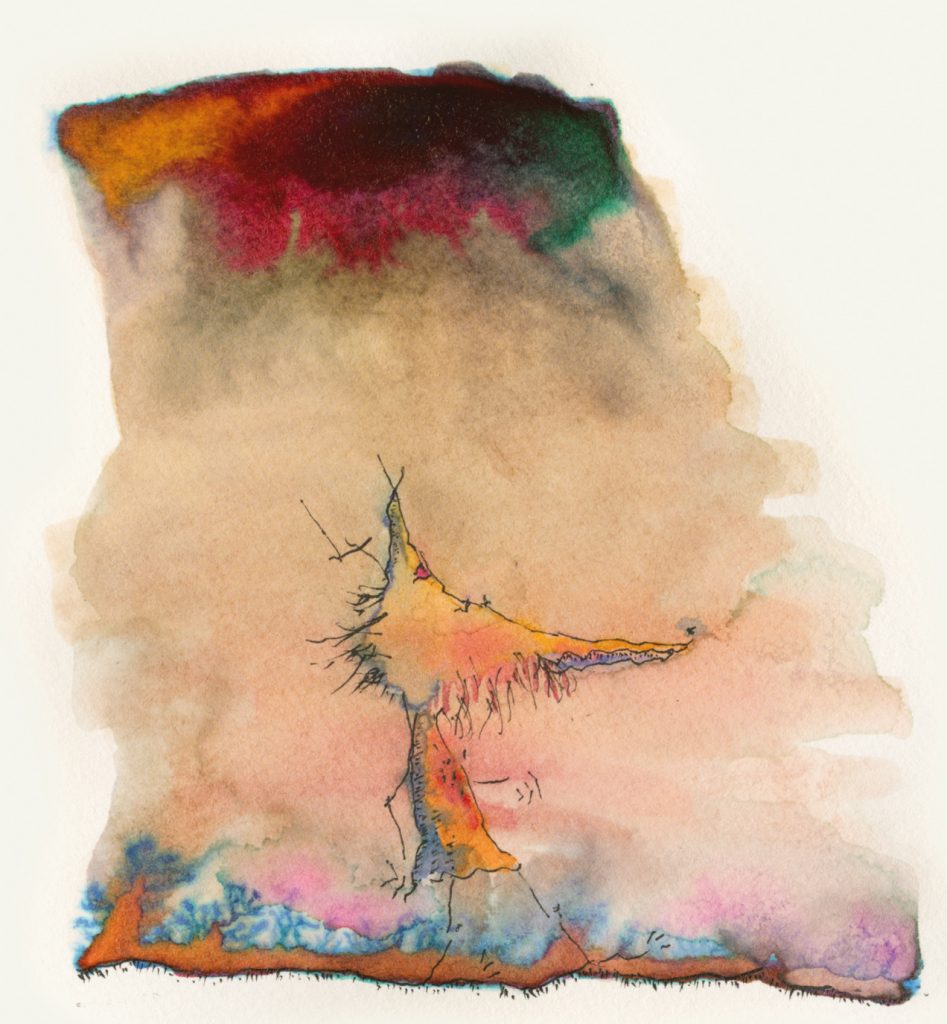This week we will continue to work with the breath and begin to incorporate other sensations in the body into our meditation practice. For this second week, you are asked to meditate for twenty minutes twice a day and to practice walking meditation for twenty minutes once a day. Instructions follow for working with sensations in the body during seated meditation and for walking meditation.
Working with Pain
We can develop the liberating gift of relating skillfully to physical pain. It is important to learn how to open to pain, because how we relate to pain in meditation is symptomatic of how we relate to all the unpleasant things in our life.
The Buddha reminded us of a great and obvious truth when he taught that being born results inevitably in growth, decay, and death. If we have a body, we can be certain that at times we will also have pain and illness, and we know for sure that our body will die. Much of meditation practice is opening to this reality in a very immediate way—not merely thinking about it, but experiencing it directly and deeply.
When physical pain predominates in your practice, you can try different strategies of awareness. First, notice the general area of sensation—for example, the knee or back. Simply be aware of the whole area, letting your mind relax and settle into the physical sensations. Second, observe precisely the particular nature of the sensations. Do you feel burning, pressure, searing, tightness, piercing, twisting, or some other variant of bodily feeling? Noting the particular quality of what you feel will help your mind to become more concentrated.
After you recognize just what is actually there, the third step brings you even deeper. Allow your awareness to pinpoint the area of greatest intensity. Notice what happens. Usually the sensation—either pain or discomfort—will change in some way, and the point of intensity will shift. Then move your attention to that point, and then to the next—something like “following the dots” of intensity.
When your mind becomes tired, come back to awareness of the whole area, or even back to your breath. It is usually better to go back and forth between the breath and the pain for intervals of several minutes at a time, because our mind has a tendency to pull back, to become tired, and lose focus during long periods of intense unpleasant feeling. Unless we work skillfully with pain, it can exhaust us, and then mindfulness and energy decrease. Alternating between the breath and the pain keeps us more alert and energetic.
The value of altering our relationship to pain goes far beyond how and where we sit. Times of discomfort teach us how to practice freedom in all those life situations that make us uncomfortable. How are we relating just now, in this moment, to discomfort, pain, not getting what we want? It will be interesting to see, over and over again, how in those situations we think are intolerable, it is often our own resistance that makes them intolerable. The problem lies not in the situations but rather in our inability to just be with them, just to open to them.
But we also need to recognize our limits in certain situations. Sometimes experiences are too overwhelming to open up to all at once. We may need to back off for a while, or to approach them gradually. Learning this balance is the key to so much of our practice. How much can we accept in a soft and gentle way before we close off, before we say, “This is too much”? Extending our limits makes us strong. Through this simple practice we develop a power of mind, a great capacity to be with painful situations. That strength transforms how we live our life.
This week, practice working with sensations in this way. Although pain is often the type of sensation that cries the loudest for attention, it is also beneficial to learn to experience pleasant sensations in this direct way, and perhaps more difficult, as it is so easy to become lost in the pleasant.
Guided Meditation: Walk the Walk
Walking meditation is the application of bare attention in movement. It becomes a model for being mindful in all the movements we make throughout the day.
Find a place, inside or outside, about ten or twenty steps in length. Stand at one end of this path for a moment and settle the attention in the body with a body scan—the practice of sending your attention to every part of your body starting on one end and moving all the way through to the other.
We’ll divide the walking period into three sections. During the first section, walk back and forth at a slightly slower-than-normal speed. As you’re doing this part of the walking practice, you can use a very simple mental label with each step. Note “left, right, left, right” or “stepping, stepping” each time the foot touches the ground.
The primary emphasis in the practice is to stay centered in the body, feeling the actual sensations of movement. The mental noting should be very soft, in the background. Use it simply as a way of helping to keep the mind connected to what’s going on.
As you’re walking at near-normal speed, feel the movement of your body. Feel the movement of the legs and the feet. Be relaxed in your body with the quality of bare attention. It’s alert, it’s receptive, it’s noticing the sensations in the movement of walking.
Notice when your mind wanders. When you notice that you are lost in a thought, simply be aware of this and come back to the step.
After walking back and forth at a speed just a little slower than normal for about ten minutes, begin to slow down. Now we’ll divide the step into two parts. Begin to note the lifting and placing, lifting and placing. Feel the specific sensations associated with each of those parts of the step. As you lift, what is it that you feel in the foot and leg? As you place, what sensations are arising? See how carefully you notice what is going on—“lift, place, lift, place.” Or you might note “Up, down, up, down.” Feel the specific sensations with each part of those steps.
After some time, slow the walking practice down even further. Now you can divide the step into three parts: “Lift, move, place” or “Up, forward, down.” Finish one step completely before lifting the other foot. Settle back into the very slow and easy rhythm, with careful attention to the sensations of lifting, the sensations of moving forward, and the sensations of lowering the foot and touching.
The rhythm of this slow walking is quite different from the way we usually move. It may take a short while for you to get used to this rhythm, where you finish one step completely before lifting the other foot. Continue at this speed, settling back into the movement, settling into your body with bare attention, feeling the subtlety of sensations with each part of the step. Try to keep the mind and body relaxed. There need not be any kind of struggle or forcing.
Feel free to experiment with the speed at which you move, keeping in mind that the guideline is mindfulness. For most people, this means starting at a somewhat faster pace, and then gradually slowing down as the mind becomes more focused and concentrated. If you find that the mind is wandering a lot, you can change the speed to a faster pace.
Generally, you place the emphasis on the sensations in the foot and leg as you move. At times, though, you can also be with the sensations of the whole body. Feel the whole body as it moves through space.
Sometimes, in the evening, if you’re feeling full of energy or restless and tired, you might find that the walking practice is actually more helpful than the sitting. Because the movement is quite obvious and tangible, people often find it easier to focus their attention in the walking. If you are struggling in your seated meditation periods in the evenings, feel free to replace them occasionally with periods of walking meditation.
Monday–Friday: Continue practicing seated meditation for twenty minutes in the morning and in the evening. This week, add a twenty-minute walking meditation session each day.
Weekend Challenge: Devote three hours this weekend to contemplation on the body in sessions of at least thirty minutes. Spend a minimum of one hour practicing walking meditation. If you are able to practice for three solid hours, try alternating between seated and walking meditation in thirty-minute periods with one half-hour break for tea. During breaks, maintain silence if possible and move carefully without rushing, paying special attention to the sensations in your body.
Nourishing the body to support the practice
 Try to take one meal each day in silence.
Try to take one meal each day in silence.- Light evening meals are traditionally encouraged to support high energy levels.
- Many practitioners appreciate a vegetarian diet during times of intense training.
♦
Commit to Sit: Tricycle’s 28-day meditation challenge
|
|
Introduction |
Working with Aversion |
The Five Precepts |
Working with Metta |
Week 1: The Breath |
Working with Sense Doors |
Week 2: The Body |
Seated Meditation Tips |
Week 3: Emotions & Hindrances |
Working with Hindrances |
Week 4: Thoughts |
Meditation Supplies |
Posture |
7 Simple Exercises |
Thank you for subscribing to Tricycle! As a nonprofit, we depend on readers like you to keep Buddhist teachings and practices widely available.
